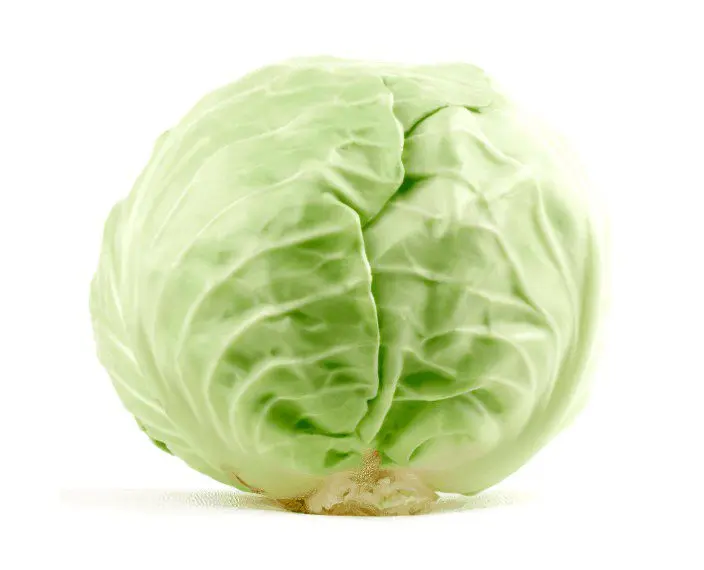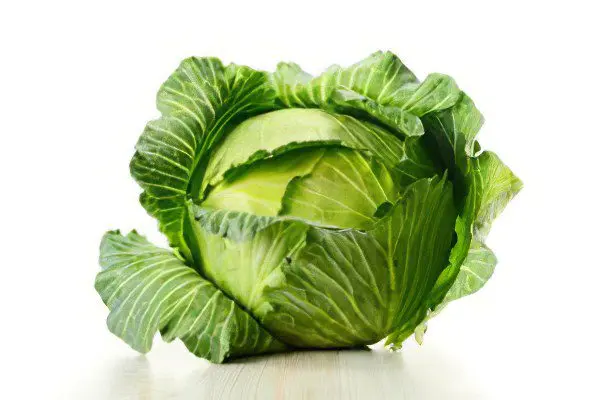Contents

White cabbage is a biennial crop from the cruciferous family. The root system of the plant is powerful, well branched. The stems are erect or semi-raised, short or elongated (depending on the variety). In the first year, a head of cabbage grows, which is a strongly overgrown apical bud. The lower leaves are alternate, petiolate, spreading, often forming a rosette, the upper ones are sessile. The leaves are large, with thick veins, their surface is smooth or wrinkled.
The birthplace of white cabbage is the Mediterranean coast, in ancient Greece it was cultivated as early as 300 BC, as can be seen from the mentions of Theophrastus. But in Rus’, cabbage began to be grown much later – for the first time, descriptions of cabbage are found in ancient manuscripts from 1073. At the same time, cabbage grew well throughout Kievan Rus, often appeared on the tables of ordinary peasants and the nobility, and it was the Slavs who first tried to ferment cabbage to ensure its safety in winter.
Sauerkraut not only has a pleasant taste and does not deteriorate, but also retains all the beneficial properties of a fresh vegetable, while being more easily absorbed by the body. Lactic acid bacteria, under the influence of which sugars from cabbage juice are converted into lactic acid, have a beneficial effect on the condition of the intestine, prevent dysbacteriosis and putrefactive processes.
By eating 200 grams of cabbage daily, you can avoid vitamin C deficiency, prevent colds and get a daily intake of fiber that stimulates digestion. Other useful substances in cabbage are phosphorus, calcium, potassium, chlorine, phosphorus and sulfur, as well as phytoncides and vitamins, among which vitamin U deserves special attention, which cannot be synthesized in the body on its own.
Benefits of white cabbage
Not everyone loves white cabbage, and even more so, only a few eat it raw. And just the latter get the maximum benefit, as they know about its hidden beneficial properties. So what are the benefits of cabbage?
Composition and calorie content
Calories 28 KKal
- Fats:
0,1 g
- Proteins:
1,8 g
- Carbohydrates:
6 g
- Water:
91,5 g
- Ash:
0,6 g
- Cellulose:
2 g
Vitamins (in 100 g): | Quantity | %RDN |
Vitamin K | 76 mcg | 63% |
Vitamin C (ascorbic acid) | 25,5-62 mg | 55% |
Vitamin B9 (folic acid) | 42-125 μg | 24% |
Methylmethioninesulfonium (vitamin U) | 16,4-20,7 mg | 9,5% |
Minerals (in 100 g): | Quantity | %RDN |
Bor | 200 mcg | 286% |
Silicon | 53 mg | 177% |
Cobalt | 3 mcg | 30% |
Molybdenum | 10 mcg | 14% |
potassium | 175-320 mg | 12% |
Manganese | 110-360 μg | 11% |
Chrome | 5 mcg | 10% |
Calcium | 42-57 mg | 6% |
Full chemical composition ➤
Other important connections:
Purine — 13 mg (10% of RDI)
Oxalic acid — 1 mg (0,3% of RDI)
8 Health Benefits of White Cabbage

The outer green leaves of white cabbage are rich in folic acid, which is necessary for the normal course of pregnancy. White cabbage leaves improve blood quality, help prevent atherosclerosis.
Cabbage supplies the body with vitamin C, which is necessary for the normal functioning of the immune system, which is especially important in autumn and winter for the prevention of colds. Ascorbic acid in cabbage is found in the form of ascorbigen, which has antitumor properties. In addition, cabbage contains pure ascorbic acid, the concentration of which can be increased by heat treatment of the vegetable – under the influence of heat, ascorbigen is converted into ascorbic acid.
The anti-sclerotic properties of cabbage are provided by tartonic acid in its composition – it slows down the conversion of carbohydrates into fats and prevents cholesterol from settling on the walls of blood vessels. However, this substance is destroyed by thermal influences, so cabbage is not recommended to be boiled, stewed and fried – this way it loses some of its useful properties. Heat also destroys vitamin C, but short-term exposure to heat helps to increase its amount in cabbage.
Cabbage helps to remove excess fluid from the body, as it contains more potassium than sodium. But sauerkraut, due to its high salt content, has the opposite effect.
Cabbage is useful for weight loss, it is recommended to include it more often in the diet of overweight people. Choline in the composition of cabbage contributes to the normalization of fat metabolism, and fiber cleanses the intestines of toxins and normalizes stools. In addition, cabbage is a low-calorie product, 100 g contains only 28 kcal, which allows you to eat it in large quantities without fear of getting better.
Cabbage juice is an excellent base for fresh vegetable juices, it can be consumed with beetroot and carrot juice. Cabbage juice is useful to drink to stimulate digestive processes, it has a neutral pH.
Cabbage is used in the diet of people with stomach and intestinal ulcers as a natural source of vitamin U and PP, which promote healing of the mucosa and normalize the secretory activity of the digestive glands.
Cabbage juice is recommended to drink for people with gastrointestinal diseases, its expectorant properties make it possible to quickly cure coughs and colds. Cabbage prevents fatty degeneration of the liver and normalizes metabolism.
Benefits of vitamin U in cabbage

Vitamin U was first discovered and described in the 40s of the twentieth century during the study of the components of the composition of cabbage juice. The name “U” – short for ulcus, which means “ulcer” – reflects one of the main beneficial properties of this substance. Vitamin U regenerates the mucosa of the digestive tract after damage caused by a stomach ulcer. But this is not its only function in the body – this vitamin is involved in a number of biochemical processes, is involved in the synthesis of vitamin B4 and other biologically active substances.
Another name for this vitamin is S-methylmethionine, it contains the amino acid methionine and, when isolated, is a yellowish or white crystalline powder that dissolves well in water and has a sweetish taste. S-methylmethionine is able to recognize foreign compounds and remove them.
The daily intake is considered to be 100-200 mg, vitamin U can only be obtained from food, since it is not synthesized in the body. White cabbage variety is the second record holder for the content of this vitamin – up to 21 mg per 100 g, so including it in the diet, you prevent heludka ulcer. Despite the fact that vitamin U is found in many vegetables, many people are deficient in it – people who abuse alcohol and smokers are at risk. The lack of this substance leads to ulcerative erosions of the mucosa, depletion of the body, and impaired digestibility of food.
[Video] Dr. Berg – Cabbage is the best remedy for stomach ulcers:









